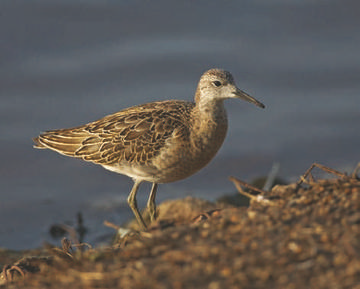Ruff (Philomachus pugnax)

Ruff © Richard Steel
Coward (1910) only knew Ruff as ‘a bird of passage in spring and autumn, both on the coast and inland; never abundant’ but Bell (1962) wrote that ‘during the last 25 years it has become well established as a winter visitor in small numbers, particularly around the Mersey marshes in the Frodsham and surrounding areas’. Numbers wintering rose considerably during the 1960s and into the 1970s at sites near the Mersey Estuary, particularly Frodsham Marsh. Sixty were there in December 1965, 110 in December 1974 and a peak of 150 in January 1977. The birds were quite mobile, also being seen on Frodsham Score and across the river at Hale where 120 on 29 January 1979 is the last three-figure count in the county at any season. Subsequently the highest winter count in the Mersey Estuary vicinity is just 18, at Frodsham Marsh in January 1998. In the winters of 1979/ 80 and 1980/ 81, Woolston held the largest numbers with December maxima of 29 and 43 respectively. In almost every subsequent winter the largest numbers have been found at Sandbach Flashes where maxima have ranged from eight in December 1982 to 42 in December 1992. Ruffs have been present at Inner Marsh Farm in every winter from 1988/ 89 with a maximum of 20 in February 1993, but otherwise the species is scarce on Wirral. Elsewhere in the county there are sporadic winter records.
Thus, this winter Atlas map presents a typical picture of Ruff, although the aggregation of three years’ records probably overstates the position. Most groups were from one to four birds strong, with the largest flocks twenty at Sandbach Flashes (SJ75J) and nine at Inner Marsh Farm (SJ37B), both in 2004/ 05. Up to five were noted on the Dee saltmarsh (SJ27X) but all other Ruffs were on inland freshwater sites, in three tetrads on wet agricultural grassland and the rest in areas whose habitat was categorised as C6, water-meadow/ grazing marsh.
Most Ruffs breed in northern Fennoscandia and Russia and winter in seasonal wetlands in trans-Saharan Africa. They mostly feed on mud-dwelling invertebrates, but some of the hundreds of thousands of birds wintering in Senegal have taken to gorging themselves on rice, making themselves a fatter and tastier target for the locals who can trap or shoot them. A tiny proportion of the population, probably birds breeding in eastern Siberia and predominantly the much larger males (Migration Atlas), spend the winter in western Europe. Wintering in Britain was first recorded in 1934, with numbers increasing to more than 1,000 during the 1970s, then falling to only a few hundred (Migration Atlas): clearly, at times, Cheshire and Wirral used to hold a significant fraction of the British total, but not now. WeBS counts have shown an increased tendency for Ruffs to winter in Britain since the late 1990s, with eight sites, all in England, now having five-year peak mean figures of more than 50 birds. That for the Dee, including Inner Marsh Farm, is 14 birds (Musgrove et al 2007).
Ruff has never bred in Cheshire and Wirral. Birds were reported during the breeding season from four tetrads – Inner Marsh Farm (SJ37B), Ashton’s Flash (SJ67S), Sandbach Flashes (SJ75J) and a farm with a flooded field near Aston (SJ64D) – but it is debatable if they offer suitable breeding habitat and whether the records should be classed as ‘H’ or ‘O’: the first three of these sites also had winter records of the species. Although some of them are males in breeding plumage with the eponymous ruff around the neck, and Sandbach Flashes (SJ75J) were visited by a male and female on 3 May 2006, most birds do not stay and move on quickly. To breed, female Ruffs need the stimulus of a communal display (lek) by several males. Three or more males have been noted displaying in the county occasionally, as in 1949 (Boyd 1951), 1963, 1991, 1997 and 1998 (CWBRs). This is one of the rarest breeding waders in Britain and the reports of the Rare Breeding Birds Panel show its scarcity: a handful of birds nested in Scotland in 2003 and 2004, but the previous record of confirmed breeding was in 1996 (Holling et al 2007). They have bred or attempted to breed in Lancashire, in eleven years from 1969 to 2002, at three different sites (White et al 2008), so any spring gathering of Ruffs in Cheshire and Wirral should be carefully monitored.
Sponsored by Mrs J. C. Bell

